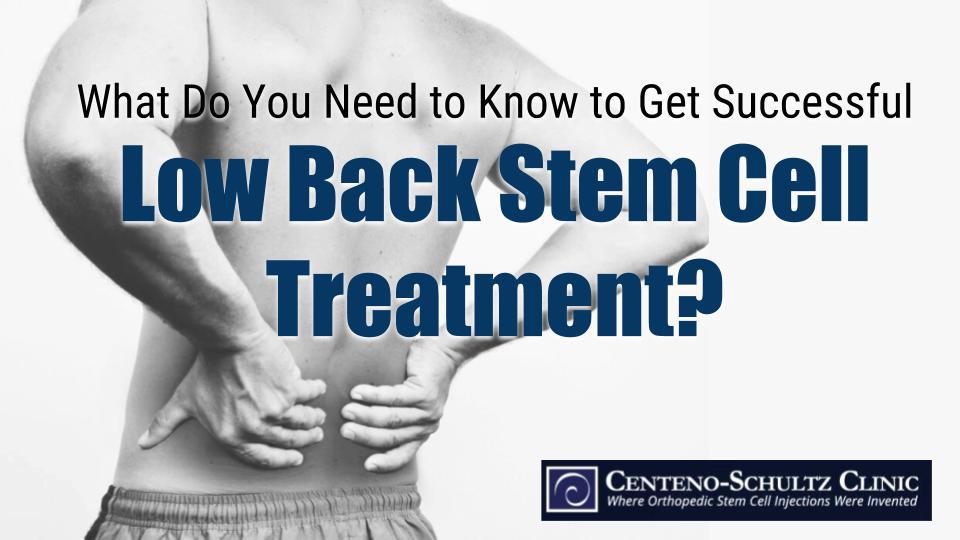You don’t have to go far to find a clinic offering stem cell treatments these days (they’re popping up everywhere), and many of them are offering these orthobiologics therapies for the low back. While finding them is easy, determining if these stem cell treatments are legitimate can be very difficult. To help you weed through all the stem cell therapies being marketed out there, we’ve put together 5 things you need to know about low back stem cell treatment.
1. Amniotic and Cord Stem Cells Are Dead
If the clinic you are considering offers amniotic or umbilical cord stem cell treatments for orthopedic conditions, there’s a big problem—amniotic and cord products contain only dead cells! In addition, regarding musculoskeletal issues, including the spine, hip, knee, and so on, there is no research that supports amniotic or cord stem cell treatments, so if a provider using these products gives you research to support the treatment, read it closely; key elements from the study (such as the type of stem cells) will not match up with the treatment the provider is offering (this is a classic case of amniotic bait and switch). Understandably, if you’re receiving an injection of stem cells, they have to be alive to be effective, so make sure your provider is using your own bone marrow stem cells for your low back stem cell treatment.
2. Quickie Bone Marrow Harvest = Lower Stem Cell Count
If you want a best chance of success with your low back stem cell treatment, stay away from clinics using a “quickie” bone marrow harvesting device (the tool that draws your bone marrow), such as the Marrow Cellutions trocar. The claims the device manufacturers make is that these tools allow providers to skip concentrating the stem cells once the bone marrow is drawn. Instead, they can just immediately reinject the bone marrow aspirate.
First, we’ve tested these quickie devices to see if they work. What did we find? As far as technique, these very expensive quickie trocars performed no better than the standard trocars we use for extracting the bone marrow. Second, not only does skipping the step of concentrating stem cells lower the stem cell count drastically, but stem cell counts should be customized to each patient and each patient’s condition, so clearly these quickie devices can’t achieve that if the provider is just directly reinjecting the bone marrow harvested. This can be of particular concern for a low back stem cell treatment because you need more stem cells for these procedures than these devices, based on our testing results, can provide.
3. Stem Cell Treatments Aren’t Blind Trigger Point Injections
An advanced image-guided low back stem cell injection with fluoroscopy is a starkly different and much more specialized procedure than an in-office trigger-point injection, which is done blindly (meaning with no image guidance). A spasm in a spot in a a muscle is called a trigger point, and it means it can no longer contract. A trigger point is actually a problem with the nerves that supply the affected muscle. With fluoroscopy guidance, low back stem cell treatment, on the other hand, can address those deep issues in the nerves, facet joints, and even the discs.
Providers outside of the specialty of interventional orthopedics are much more likely to be performing these lower quality stem cell injections as blind trigger point injections in the muscle, not in the actual affected low back structures (e.g., the discs, nerves, facet joints, etc.). If the clinic doesn’t have both ultrasound and fluoroscopy technology for guidance for every injection, and is instead only performing blind injections, this isn’t the right clinic for your low back stem cell treatment.
4. Stem Cell Treatments Won’t Regrow Bone-on-Bone Discs
There is no magic low back stem cell treatment (no matter the stem cell source) that can regrow a brand-new that has collapsed (bone-on-bone) due to advanced degenerative disc disease. Beware of any clinic claiming they can do this as it is not a legitimate claim; it is a scam.
5. Epidural Platelet Lysate Often Sufficient
For over a decade-plus, we have provided low back orthobiologic treatments and have found that while some patients do indeed need disc stem cell injections, many do not. An epidural platelet lysate (PL) is often sufficient to help patients. Depending on the condition, stem cell injections in the disc aren’t always the best solution. Image-guided epidural PL injections involve concentrating blood platelets and then isolating the growth factors from the platelets; the result is platelet lysate.
First and foremost, make sure the physician performing your orthopedic stem cell therapy is an interventional orthopedics physician who has specialized training through the Interventional Orthopedics Foundation. If the person the clinic provides to perform your stem cell procedure is a chiropractor, nurse practitioner, physician assistant, naturopath, or acupuncturist (in other words, anyone who is not an actual interventional orthopedics physician), this is not who you want injecting stem cells into your low back, or any other part of your musculoskeletal system.

